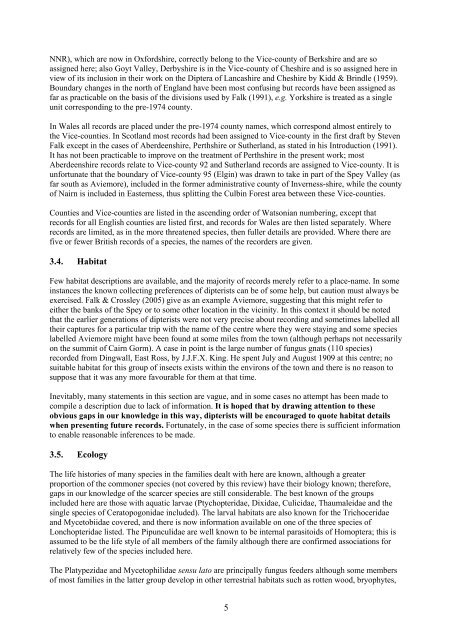Part 2: Nematocera and Aschiza not dealt with by Falk (1991) - JNCC
Part 2: Nematocera and Aschiza not dealt with by Falk (1991) - JNCC
Part 2: Nematocera and Aschiza not dealt with by Falk (1991) - JNCC
Create successful ePaper yourself
Turn your PDF publications into a flip-book with our unique Google optimized e-Paper software.
NNR), which are now in Oxfordshire, correctly belong to the Vice-county of Berkshire <strong>and</strong> are so<br />
assigned here; also Goyt Valley, Der<strong>by</strong>shire is in the Vice-county of Cheshire <strong>and</strong> is so assigned here in<br />
view of its inclusion in their work on the Diptera of Lancashire <strong>and</strong> Cheshire <strong>by</strong> Kidd & Brindle (1959).<br />
Boundary changes in the north of Engl<strong>and</strong> have been most confusing but records have been assigned as<br />
far as practicable on the basis of the divisions used <strong>by</strong> <strong>Falk</strong> (<strong>1991</strong>), e.g. Yorkshire is treated as a single<br />
unit corresponding to the pre-1974 county.<br />
In Wales all records are placed under the pre-1974 county names, which correspond almost entirely to<br />
the Vice-counties. In Scotl<strong>and</strong> most records had been assigned to Vice-county in the first draft <strong>by</strong> Steven<br />
<strong>Falk</strong> except in the cases of Aberdeenshire, Perthshire or Sutherl<strong>and</strong>, as stated in his Introduction (<strong>1991</strong>).<br />
It has <strong>not</strong> been practicable to improve on the treatment of Perthshire in the present work; most<br />
Aberdeenshire records relate to Vice-county 92 <strong>and</strong> Sutherl<strong>and</strong> records are assigned to Vice-county. It is<br />
unfortunate that the boundary of Vice-county 95 (Elgin) was drawn to take in part of the Spey Valley (as<br />
far south as Aviemore), included in the former administrative county of Inverness-shire, while the county<br />
of Nairn is included in Easterness, thus splitting the Culbin Forest area between these Vice-counties.<br />
Counties <strong>and</strong> Vice-counties are listed in the ascending order of Watsonian numbering, except that<br />
records for all English counties are listed first, <strong>and</strong> records for Wales are then listed separately. Where<br />
records are limited, as in the more threatened species, then fuller details are provided. Where there are<br />
five or fewer British records of a species, the names of the recorders are given.<br />
3.4. Habitat<br />
Few habitat descriptions are available, <strong>and</strong> the majority of records merely refer to a place-name. In some<br />
instances the known collecting preferences of dipterists can be of some help, but caution must always be<br />
exercised. <strong>Falk</strong> & Crossley (2005) give as an example Aviemore, suggesting that this might refer to<br />
either the banks of the Spey or to some other location in the vicinity. In this context it should be <strong>not</strong>ed<br />
that the earlier generations of dipterists were <strong>not</strong> very precise about recording <strong>and</strong> sometimes labelled all<br />
their captures for a particular trip <strong>with</strong> the name of the centre where they were staying <strong>and</strong> some species<br />
labelled Aviemore might have been found at some miles from the town (although perhaps <strong>not</strong> necessarily<br />
on the summit of Cairn Gorm). A case in point is the large number of fungus gnats (110 species)<br />
recorded from Dingwall, East Ross, <strong>by</strong> J.J.F.X. King. He spent July <strong>and</strong> August 1909 at this centre; no<br />
suitable habitat for this group of insects exists <strong>with</strong>in the environs of the town <strong>and</strong> there is no reason to<br />
suppose that it was any more favourable for them at that time.<br />
Inevitably, many statements in this section are vague, <strong>and</strong> in some cases no attempt has been made to<br />
compile a description due to lack of information. It is hoped that <strong>by</strong> drawing attention to these<br />
obvious gaps in our knowledge in this way, dipterists will be encouraged to quote habitat details<br />
when presenting future records. Fortunately, in the case of some species there is sufficient information<br />
to enable reasonable inferences to be made.<br />
3.5. Ecology<br />
The life histories of many species in the families <strong>dealt</strong> <strong>with</strong> here are known, although a greater<br />
proportion of the commoner species (<strong>not</strong> covered <strong>by</strong> this review) have their biology known; therefore,<br />
gaps in our knowledge of the scarcer species are still considerable. The best known of the groups<br />
included here are those <strong>with</strong> aquatic larvae (Ptychopteridae, Dixidae, Culicidae, Thaumaleidae <strong>and</strong> the<br />
single species of Ceratopogonidae included). The larval habitats are also known for the Trichoceridae<br />
<strong>and</strong> Mycetobiidae covered, <strong>and</strong> there is now information available on one of the three species of<br />
Lonchopteridae listed. The Pipunculidae are well known to be internal parasitoids of Homoptera; this is<br />
assumed to be the life style of all members of the family although there are confirmed associations for<br />
relatively few of the species included here.<br />
The Platypezidae <strong>and</strong> Mycetophilidae sensu lato are principally fungus feeders although some members<br />
of most families in the latter group develop in other terrestrial habitats such as rotten wood, bryophytes,<br />
5
















